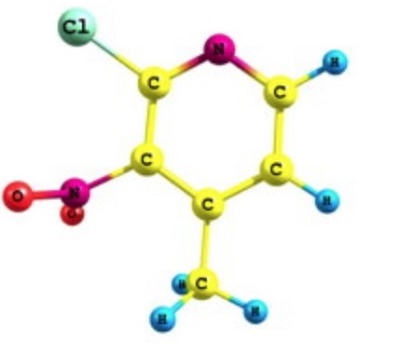| Identification | More | [Name]
2-Chloro-4-methyl-3-nitropyridine | [CAS]
23056-39-5 | [Synonyms]
2-CHLORO-3-NITRO-4-METHYLPYRIDINE
2-CHLORO-3-NITRO-4-PICOLINE
2-CHLORO-4-METHYL-3-NITROPYRIDINE
PYRIDINE, 2-CHLORO-4-METHYL-3-NITRO-
2-CHLORO-3-NITRO-4-PICOLINE (2-CHLORO-4-METHYL-3-NITROPYRIDINE)
3-Nitro-2-chloro-4-methylpyridine | [Molecular Formula]
C6H5ClN2O2 | [MDL Number]
MFCD00012347 | [Molecular Weight]
172.57 | [MOL File]
23056-39-5.mol |
| Chemical Properties | Back Directory | [Appearance]
Light yellow Cryst | [Melting point ]
51-53 °C (lit.) | [Boiling point ]
279.6±35.0 °C(Predicted) | [density ]
1.406±0.06 g/cm3(Predicted) | [Fp ]
>230 °F
| [storage temp. ]
Keep in dark place,Sealed in dry,Room Temperature | [solubility ]
Chloroform (Slightly), DMSO (Slightly), Methanol (Slightly) | [form ]
Powder | [pka]
-1.80±0.10(Predicted) | [color ]
Yellow to beige | [Sensitive ]
Hygroscopic | [InChI]
InChI=1S/C6H5ClN2O2/c1-4-2-3-8-6(7)5(4)9(10)11/h2-3H,1H3 | [InChIKey]
JHARVUVBTAAPLA-UHFFFAOYSA-N | [SMILES]
C1(Cl)=NC=CC(C)=C1[N+]([O-])=O | [CAS DataBase Reference]
23056-39-5(CAS DataBase Reference) |
| Safety Data | Back Directory | [Hazard Codes ]
Xi,Xn | [Risk Statements ]
R36/37/38:Irritating to eyes, respiratory system and skin .
R21/22:Harmful in contact with skin and if swallowed . | [Safety Statements ]
S26:In case of contact with eyes, rinse immediately with plenty of water and seek medical advice .
S37/39:Wear suitable gloves and eye/face protection .
S36/37/39:Wear suitable protective clothing, gloves and eye/face protection .
S36:Wear suitable protective clothing . | [RIDADR ]
UN2811 | [WGK Germany ]
3
| [HazardClass ]
6.1 | [PackingGroup ]
III | [HS Code ]
29339900 |
| Hazard Information | Back Directory | [Chemical Properties]
Light yellow Cryst | [Uses]
2-Chloro-4-methyl-3-nitropyridine is a cyclopropyldipyridodiazepinone derivative for use as non-nucleoside reverse transcriptase inhibitors.
| [Definition]
2-Chloro-4-methyl-3-nitropyridine (2C4M3NP) is a nitropyridine derivative that could form an acceptor fragment of 2-adamantylamino-5-nitropyridine (AANP). This crystal shows a particularly large optical non-linearity. It is observed that the mean C-C (ring) bond distance calculated between the ring carbon atoms of 2C4M3NP is 1.387 Å. In X-ray data of pyridine, the mean C-C (ring) bond distance is 1.394 Å. The C-H bond distances are found to be 1.081 Å. The computed values of C-C (ring) and C-H are slightly higher than that of the experimental value. This is attributed to the substituents present in the pyridine. The C-C-C bond angle where the -Cl and -NO2 group is attached with the middle carbon is more than 120? while the C-C-C bond angle where the -CH3 is substituted is less than 120? in 2C4M3NP. The N-C-CH3 bond angle (116.3。) is less than that of the C-C-CH3 (124.2。) probably due to the weak hydrogen bond formed between the nitrogen and hydrogen of the methyl group[1].

| [General Description]
Experimental FTIR and FT-Raman spectroscopic analysis of 2-chloro-4-methyl-3-nitropyridine was reported. | [References]
[1] Arjunan, V. , et al. "A comparative study on vibrational, conformational and electronic structure of 2-chloro-4-methyl-3-nitropyridine and 2-chloro-6-methylpyridine." Spectrochimica Acta Part A Molecular & Biomolecular Spectroscopy 92.none(2012):305-317.
|
|
|